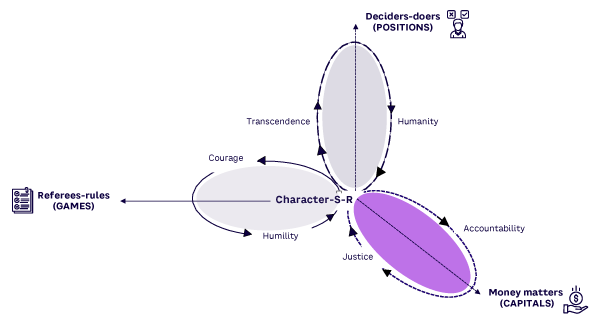AMPLIFY VOL. 37, NO. 4

Many CEOs are no longer uttering the letters E-S-G.1 Larry Fink, CEO of BlackRock, confessed, “In my last CEO letter, the phrase ESG was not uttered once, because it’s been unfortunately politicized [and] weaponized. Our business was hurt. We lost $4 billion because of 90% misinformation.”2
How do CEOs lead in the eye of the ESG (environment, social, and governance) storm? Silently, perhaps. One thing is certain: their character and judgment are tested as they face the tensions, trade-offs, and dilemmas of ESG while making decisions that impact the prosperity and sustainability of our future.3
In this article, we illustrate how today’s frames affect tomorrow’s leaders and leadership. Our work is based on a series of executive conversations designed to explore the influence and impact of leaders’ character on corporate social responsibility (CSR).
Through three North Atlantic roundtables, hosted by the Ian O. Ihnatowycz Institute for Leadership at the Ivey Business School and The Long Run Institute (both located in Canada), we engaged with more than 50 top executives from a variety of sectors to explore leadership in the eye of the ESG storm.
We learned that top leaders tend to construct their ESG strategies through the lenses or frames of Games (with referees and rules), Positions (with some being deciders and some doers), or Capitals (with money overpowering other capitals).4 Simply put, ESG strategies are neither given nor static. Rather, they evolve depending on the character dimensions of the leaders who envision and enact them (see Figure 1).

Although character is a holistic construct of 11 interconnected dimensions5 (or virtues), we found that each frame elevates two character dimensions into a unique and dynamic tension: courage and humility, transcendence and humanity, justice and accountability. By living and leading amid these inner tensions, leaders evolve what CSR means to them, their boards, and their stakeholders. Elevating character compels many top leaders to radically rework ESG.
Through the roundtables, we caught a rare glimpse at how leaders connect their inner and outer worlds as they brace for increasingly polarized CSR. We discussed the three lenses and learned that although the future of CSR may no longer explicitly contain the letters ESG, it is more purposeful than ever. Today’s leaders can make tomorrow more responsible by turning inward and taking social responsibilities personally as they “triple down” on purpose.
We call our framework Character-S-R to underscore that beneath every compelling commitment to ESG, there are deeply felt aspects of who one is and how one aims to show up as a leader. Strong, well-developed character is critical to any individual’s performance, judgment, and success (in any job, at any level), but top leaders are often held to a higher standard. We expect those who safeguard our futures, feed our children, or invest our money to be of virtuous character. Departures from virtuous behaviors tend to be more visible at the top, too. What is often missed are the connections between who a leader is and how one leads. In the eye of the ESG storm, such connections cannot be taken for granted.
The Purpose Paradigm
In Character: What Contemporary Leaders Can Teach Us About Building a More Just, Prosperous, and Sustainable Future, authors Gerard Seijts and Kimberly Young Milani call on leaders to be the architects of “a more inclusive, sustainable, and resilient world.”6 Indeed, in an era of poly-crisis (multiple global crises) or even perma-crisis (an extended period of instability and insecurity), can organizations be reimagined as sites for expressing and pursuing purpose?
Research on organizational purpose is still in its infancy. But while the academic jury is debating whether purpose could be valuable to both organizations and society,7 many leaders have already embraced purpose as essential to the challenges of our time.8
The need for responsible leadership is hardly new, but the stakes of leading responsibly have never been higher. Authors in leading business outlets such as Harvard Business Review, Financial Times, and Forbes are tightening the tension from both sides.9-11 On the one hand, they warn about getting ESG “just right.” On the other hand, they call on leaders to act purposefully.
Making purpose relevant for practice and bringing purpose into the boardroom when the world is “on fire”12 can feel so daunting that some have described these tensions as the “purpose paradigm.”13,14 How leaders solve this paradigm will change the future of CSR.
The character dimensions and behaviors that leaders activate matter.15,16 Character shapes the views we hold, the decisions we make, and our subsequent behavior. This can include:
-
What we notice within the context we are operating
-
How we interact with the world around us
-
Who we engage in conversation and how we conduct those conversations
-
How we interpret feedback from others
-
What critical issues we choose to act on
-
How we deal with conflict and disappointment
-
Our willingness to examine and dismantle our own biases
-
The goals we set for the groups or organizations we lead
-
The kind of culture we allow to flourish within our organizations
3 Futures
Three analogies and visions of the future emerged among executives during the North Atlantic roundtables on leadership in the eye of the ESG storm:
-
When leaders brace for grand challenges with courage (brave, determined, tenacious, resilient, and confident) and humility (self-aware, modest, reflective, curious, continuous learner, respectful, grateful, and vulnerable), the future focuses on the rules and the referees in the game of CSR and ESG.
-
When leaders balance transcendence (appreciative, inspired, optimistic, creative future-oriented, and purposive) with humanity (considerate, empathetic, compassionate, magnanimous, and forgiving), the future looks bleak or bright depending on who serves whom.
-
When money matters above all else, and the tension exists between a sense of justice (fair and equitable, proportionate, even-handed, socially responsible) and a sense of accountability (taking ownership, accepting consequences, being conscientious and responsible), the future revolves around trade-offs among precious capitals.
Is one of these futures better for CSR? The key insight of the Character-S-R framework is that the future is plural, not singular. Most leaders tend to see the future through one of these three lenses at a given time, but many boardrooms have the capacity (perhaps even the duty) to engage all three futures at once.
Making more room for all dimensions of our character is not only the job of the purposeful CEO, it is a new form of work (we call this “character work”). As debates polarize the future of CSR, leaders may get quieter on ESG, but grow louder on purpose. Seen through a character lens, the poly-crisis that today’s leaders face may not only seem a little more manageable but a lot more worthwhile.
Games (Referees-Rules)
Many ESG issues challenge the rules of the game (and often change them). Taking the game seriously requires respecting its rules, especially when the game remains unclear, and at least some of the rules are not favorable.
Leaders embracing this future keep their proverbial eye on the competition. They underscore the need for everyone to join the game and play by the same rules, not because the rules are always smart, but because even stupid rules can be improved through repeated plays.
The future of CSR looks bright when the game is taken seriously. Refereeing the game while rules are being figured out becomes important. The leaders we met explained that playing new games requires both courage (to play the game when the rules are not yet fleshed out or understood by all) and humility (to accept the decisions of referees who may be figuring out the rules or to call your own foul when it becomes clear that a rule has been violated).
As leaders co-activate courage and humility, they begin to see their competitors as collaborators in creating, evolving, and enacting the rules of the game. When players come to appreciate that the rules are far from perfect, and the decisions of referees may at times be flawed, they take up more, rather than less, responsibility.
They can choose to play more seriously, not because of the rules or the referees, but because they are committed to improving the quality and integrity of the game. As more competitors join in, and the number of serious players increases, the rules can improve much faster — and so can the decisions of the referees.
Leaders underscored the importance of rules and referees as separate from the players. They emphasized the difference between making the rules and playing by the rules. Players can choose to suffer some short-term imperfections for the sake of bettering the game for everyone in the long term. For example, leaders could co-activate courage and humility by:
-
Creating circular ecosystems and innovative forms of collective action
-
Moving from linear to circular to bio-circular to regenerative supply chains17
Without courage, no player would get into a game they know is far from clear to all, including the referees. Without humility, none would engage in continuous learning until better possibilities could be collectively found. Taking the game of the future seriously in a collective way can reveal previously unthinkable (let alone doable) recipes for CSR.
Positions (Deciders-Doers)
Conversations around the tension between purpose and profit highlight an uncomfortable social divide: those “in charge” are only a few, and thus the position to make consequential decisions is in limited hands. Viewed through a rigid decider-doer relationship, the future of CSR is one in which too many stand to lose in order for a few to win.
How can equality and equity become the new default? A new conceptualization of the economy as cooperative18 draws attention to a so-called ROH (return on humanity).19 What if we reversed the decider-doer relationship, which many feel lies at the root of human exploitation in capitalism? Could the future of work recast a subservient relationship into one of co-flourishing? Perhaps this analogy has been holding leaders back from their potential to serve, and shape, a much more inclusive future — one that celebrates our shared humanity.
Many ESG issues remain, of course, rife with inhumanities. Inhumanity sometimes serves as an impetus for change, stirring up a moral duty to do better. But too often, the damage done by business unfolds out of sight, remaining out of mind for most leaders. Nevertheless, many of the dynamics that today’s businesses hinge upon and perpetuate are being brought to light, creating a growing awareness and discomfort in many leaders.
For example, no case can be made for unsafe recycling systems in the name of electronic overconsumption or for large swaths of people going hungry while a third of the food produced goes to waste. Yet such inequities persist due to the profound gap between this social reality and a viable business case.
Overcoming our current inertia will require deliberate decisions at scale. Some new cases have been created that take a more inclusive approach to business and generate benefits for a broader range of stakeholders, but they need to be created and employed more expansively. Many leaders are realizing that change begins with and behooves the “deciders.” Those in charge today should change tomorrow’s production systems.
Undoing past wrongs may not be in the job description of most leaders. But many can choose to call up more humane futures. Indeed, when leaders activate their humanity, they begin to invest in, and will seek returns on, humanity.
For the participants in the North Atlantic roundtables, AI was perhaps the most important and urgent arena for beginning to reverse this uncomfortable tension. It is not hard to fathom what a future with AI deciders and human doers would look like (it is rarely, if ever, a future anyone hopes to see). Nor is it hard to shore up commitments to actions that would safeguard us against such a future. Leaders have begun to prepare for futures where AI can be balanced by human empathy, listing human capabilities such as being collaborative, creative, resilient, and empathetic as key requirements for the future of work. They anticipate good returns from drawing such skills to their organizations.
The discomfort this lens engenders can be transformative: it is only when we deliberately reverse the lens and ponder both sides at once that we begin to truly value what we have taken for granted or ignored for too long: our shared humanity.
Capitals (Money Matters)
There are many kinds of capital (financial, human, social, intellectual, and so forth), but ESG polarization has made it all about the money. Where the money goes (or no longer goes) is seen by some as a tool to reallocate risks and even radically redesign the future. In fact, recent swings have made it harder and more costly for industries associated with ESG (or “C” for climate) risks, such as mining or oil and gas, to obtain capital.
Leaders and organizations increasingly feel caught between a “BlackRock” and a hard place. In other words, they are becoming more and more reticent to announce any type of ESG effort or initiative (even those already underway) to avoid backlash from anti-ESG stakeholders or prevent exclusion from investor portfolios. When even BlackRock can get blacklisted by US states that are moving to enshrine anti-ESG measures, it is a reasonable worry of less powerful firms that their commitments to decarbonize by divesting in fossil fuels could lead to negative outcomes in some areas.
Reducing all matters to money (particularly shareholders’ money) skips over the importance of leaders’ accountability for all the capital their operations rely on. However, when leaders balance a heightened sense of accountability with a sense of justice for the multiple holders of those capitals, the new future of CSR surfaces and is consequential. Asking “justice for whom?” and “accountability to whom?” becomes a central question.
In an era of poly-crisis, leaders must aim for a deeper understanding of how the underlying structure of capital still needs to change. Otherwise, the economies of the future cannot become less unjust in the near term and more just in the long term.
With a disproportionate amount of today’s attention on “who has what,” we all still have so much to lose. The times call for us to exact better ways of stewarding the resources we have long taken for granted before they completely collapse.
Taking their cue from abandoned fishing villages turned into hubs of sustainable tourism or the birth of the bio-economies in today’s wastelands, many leaders are asking themselves what accountability for a radically different future means. What are the many capitals available if the future is reimagined as just and inclusive in the first place? What capitals can be valorized as we construct the futures we want instead of those we don’t?
There are, of course, many who continue to enjoy the status quo and would prefer that little changes. There are many more, however, who have been disenfranchised by decisions that enriched the few by impoverishing the set of capitals we have and hold. The future of CSR hinges on leaders who can broaden their accountability in ways that enfranchise new stakeholders and encourage new ways to put their capitals to work for the greater good.
Moving Forward
The Character-S-R framework offers an anchor to corporations adjusting to the winds of politically charged CSR.
Some leaders find ESG declarations too risky (or even a dirty word), but few can do without character dimensions like courage, transcendence, and accountability. Fewer still would want to be courageous without humility, transcendent without humanity, or accountable without justice, as it would certainly compromise both their judgment and subsequent actions.
Character can be easier to push and harder to hush than organizational commitments because of its proven position as a foundational component of leadership and its criticality to performance excellence and sustained individual and organizational well-being.
We invite leaders to preview the future of CSR as the poly-activation of character dimensions. For example, as leaders co-activate a broader expanse of dimensions, including temperance, integrity, drive, and deep collaboration, their judgment becomes stronger and additional futures open up. And as more character dimensions are exercised, future leaders become more inclusive, collaborative, and sustainable — with or without the letters E, S, and G.
We invite leaders to consider this: who they are influences the future they see, and the future they see influences who they become. Viewing the future as Games, Positions, or Capitals elevates situationally appropriate combinations of character dimensions while maintaining the activation of all character dimensions to ensure leadership efficacy. Being aware of how today’s frames inspire and evolve tomorrow’s leaders and leadership is, perhaps, the most critical aspect to the future of CSR and the flourishing of organizations, humans, and the planet.
References
1 Cutter, Chip, and Emily Glazer. “The Latest Dirty Word in Corporate America: ESG.” The Wall Street Journal, 9 January 2024.
2 MacBride, Elizabeth. “Stepping into the Fray with Larry Fink at the Aspen Ideas Festival.” Forbes, 20 September 2023.
3 Seijts, Gerard, and Kimberly Young Milani. Character: What Contemporary Leaders Can Teach Us About Building a More Just, Prosperous, and Sustainable Future. ECW Press, 2024.
4 Vera, Dusya, Oana Branzei, and Kimberly Young Milani. “Exploring ESG and the Future of Work Through the Lens of Character Leadership and Purpose.” Ian O. Ihnatowycz Institute for Leadership, Ivey Business School, 2024.
5 Crossan, Mary, Gerard Seijts, and Jeffrey Gandz. Developing Leadership Character. Routledge, 2015.
6 Seijts and Milani (see 3).
7 Lashitew, Addisu A., Oana Branzei, and Rob van Tulder. “Community Inclusion Under Systemic Inequality: How For-Profit Businesses Pursue Social Purpose.” Journal of Management Studies, Vol. 61, No. 1, January 2023.
8 Henderson, Rebecca. “Innovation in the 21st Century: Architectural Change, Purpose, and the Challenges of Our Time.” Management Science, Vol. 67, No. 9, October 2020.
9 Polman, Paul, and Andrew Winston. Net Positive: How Courageous Companies Thrive by Giving More Than They Take. Harvard Business Review Press, 2021.
10 Damordaran, Aswath. “ESG Is Beyond Redemption: May It RIP.” Financial Times, 23 October 2023.
11 Pontefract, Dan. “Deep Purpose: The Key to a Better World.” Forbes, 11 June 2022.
12 Henderson (see 8).
13 McGahan, Anita M. “The Purpose Paradigm: Towards a Common Understanding of Corporate Purpose.” Rotman Management Magazine, 1 January 2022.
14 McGahan, Anita M. “The New Stakeholder Theory on Organizational Purpose.” Strategy Science, Vol. 8, No. 2, February 2023.
15 Vera, Dusya, and Ana Ruiz Pardo (eds.). “Character Leadership as a Competitive Advantage.” Amplify, Vol. 36, No. 12, 2023.
16 Vera, Dusya, and Ana Ruiz Pardo (eds.). “Embedding Character Leadership into Organizational DNA.” Amplify, Vol. 37, No. 1, 2024.
17 Gualandris, Jury, et al. “Unchaining Supply Chains: Transformative Leaps Toward Regenerating Social-Ecological Systems.” Journal of Supply Chain Management, Vol. 60, No. 1, December 2023.
18 Lavie, Dovev. The Cooperative Economy: A Solution to Societal Grand Challenges. Routledge, 2023.
19 White, Philippa J. Return on Humanity: Leadership Lessons from All Corners of the World. Practical Inspiration Publishing, 2024.





